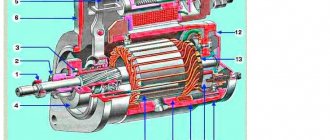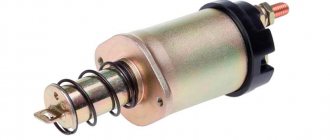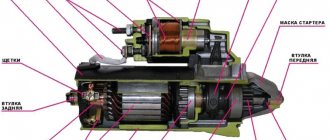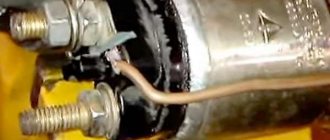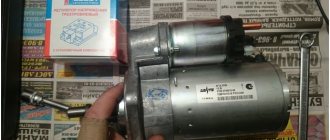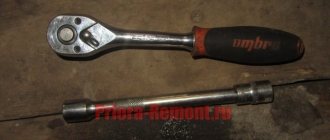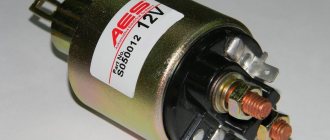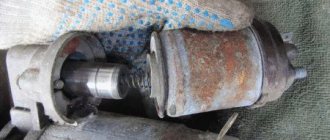Starter repair usually occurs on old cars, since this unit is quite reliable and lasts for many years without breakdowns, but no one is immune from low-quality parts and assembly. The most common malfunction is burning of the contacts on the retractor; there may also be a malfunction in the drive overrunning clutch or wear of the contact brushes. Disassembling the starter is not a difficult task and requires a small set of standard tools. The first thing to do is remove the starter from the car.
Next we will repair the traction relay. Repair may involve cleaning the contacts or replacing them completely, but first you need to remove it.
After removing the retractor, check whether the bolts are closed by the contact plate. To do this, push the armature in as far as it will go and measure the resistance on the contact bolts with an ohmmeter. If it is missing, then we replace the relay or repair it.
If you had a breakdown of the traction relay, then the disassembly ends here, but if everything is more serious, then we proceed to the next stage. To replace the brushes, armature, bendix, and starter gearbox parts, you will need complete disassembly.
How to quickly remove the starter on a VAZ 2110 with your own hands
A starter is a unit that is used to start the engine.
Essentially, this is an electric motor that rotates the engine flywheel through a clutch until the flammable liquid ignites and the engine starts. There can be many reasons for replacing or repairing the starter:
- a grinding noise in the engine compartment when turning the ignition key to start (bendix malfunction or flywheel wear);
- clicks when turning the key (retractor relay);
- The engine is difficult to turn (rotor brushes are worn out).
Starter VAZ 2110
These are the main reasons; an electrician will tell you in more detail during disassembly and diagnostics. Basically, it can be repaired, but if reasons such as replacing the armature arise, then it is advisable to replace the entire starter assembly, but the problem arises: how to remove the starter on a VAZ 2110?
Node malfunctions
The most common starter breakdowns are divided into several types. These include:
- Damage to the electrical circuit. A sign of such problems is slow rotation or complete absence of it at the crankshaft when starting the internal combustion engine. The reasons for this phenomenon may be a discharge of the battery, rupture of the contacts of the ignition device, unreliable fixation, wear of the wires, or violation of the integrity of the wiring suitable for the relay contact group. If, when starting the internal combustion engine, the armature does not respond and the relay does not operate, then the cause of the failure is most likely due to a break in the solenoid relay wire. In the absence of the described “symptoms”, it is necessary to dismantle, check the plates for short circuits, and the presence of traces of “burning” in the collector system.
- Worn starter brushes. The presence of such problems may be indicated by difficulty starting the car, but not always. The reason for this phenomenon may be “hidden” in a battery failure. Complete wear of the brushes leads to the spring “resting” against the brush holder (contact is ensured only due to its mass). This can be easily checked by changing the position of the starter. The reason for premature wear is the misalignment of the brushes during the operation of the starter.
- Broken traction relay. This is indicated by a failure of the internal combustion engine, since it will not be possible to start the engine without a working relay. The “symptoms” of a malfunction of this starter element include its rapid rotation, even after starting the internal combustion engine, idling movement (without contact with the flywheel of the engine, which does not start), and a click after turning the key in the ignition device. It may not exist if there is a break in the coil, the armature is jammed, or there is no power for some reason.
- Lack of starter rotation with a characteristic “buzzing” sound. This phenomenon indicates the occurrence of a short circuit in the electrical circuit, in which power is supplied to the brushes of the electric motor. However, it is in working condition. In such a situation, the holding coil often does not work and the bendix does not move. Its gear cannot engage the flywheel gear, and the electric motor runs in idle mode. The reason may be that the force of the retracting element “enters” the bendix through a lever made of plastic (has the shape of a grip). If the movement resistance of the bendix is high, then the plastic elements break down. As a result, it is not moved to the working position and the starter rotates, but does not transmit torque to the flywheel. Another reason for the failure of the rotor can be severe wear of the teeth, which are located on the rotor shaft of the electric motor. Do not forget that complete destruction of the mentioned teeth can also cause failure. This type of malfunction is related to the breakdown of the motor and is not related to the functioning of the drive. The presence of such a breakdown is indicated by the activation of all starter mechanisms, that is, the rotation of the electric motor and the transition of the bendix to the working position. It can be locked by turning the key in the ignition.
Many car enthusiasts complain that the battery discharges quickly and cannot activate the starter. You can read about the reasons for battery discharge here:
The main malfunctions of the unit include: the appearance of oxide on the wires and terminals, failure of the traction relay and traction winding, wear of the brushes, breakage of the armature
The listed faults can cause more serious problems if they are not corrected in time. Ignoring problems will most likely lead to vehicle failure at the most inopportune moment. The best solution is to contact a specialized service station when the first signs of the listed problems appear.
The following material will help you figure out why the starter does not turn in a VAZ 2110 car:
Replacement
To remove the VAZ 2110 starter, you need a pit (preferably), a key for 10, a key for 13, a key for 15, and a key for 8. It is advisable that the engine is cooled. We remove the negative terminal of the battery, remove the protection, if there is one, and use keys 8 and 10 to remove the tin cover for the gearbox protection. We remove the power wire plug from the starter; just pull it towards you. Using a 13 key, unscrew the power wire to the solenoid relay; it is advisable to move the wires to the side, no matter what gets in the way during dismantling. Using a 15 wrench, unscrew the two nuts securing the starter to the gearbox housing. We're filming.
After removal, it is necessary to check the condition of the bushings in the gearbox housing for wear; the armature shaft should fit in without play or jamming. In case of these defects, it is necessary to replace the bushings.
Starter relay (retractor)
The starter retractor relay is located on the starter itself and serves to move the bendix to the flywheel, and then engage with it. This relay often fails due to poor workmanship. It is quite easy to understand that the solenoid relay has failed; with such a breakdown, the starter will spin at idle, but the engine will not rotate, since the moving part of the drive (bendix) will not engage with the flywheel.
Bendix replacement
If the reason is wear of the solenoid relay or bendix of the VAZ 2110, you can carry out this work yourself. In order to remove the solenoid relay, unscrew the fastening of the power wire from the starter housing with a 13 key. Using a 8 key, unscrew the two bolts securing the solenoid relay to the starter housing, be careful, when unscrewing the bolts, there is a spring in the solenoid relay, which can cushion when removing hold with your hand. Next, remove the retractor relay piston from the rocker arm hook on the Bendix and install a new retractor relay in reverse order.
To replace the bendix, remove the solenoid relay, unscrew the two long bolts with a 10mm wrench on the back of the starter and disconnect the starter housing and its front part with the fork, bendix and rotor. Using a screwdriver, remove the plastic fork from the armature and remove the armature with the bendix from the front of the body. Remove the retaining ring from the armature tip and dismantle the bendix. Assembly is carried out in reverse order. When installing a new bendix, it is recommended to lubricate the splines with LITOL lubricant.
How to disassemble and repair the VAZ 2110 starter?
It is impossible to troubleshoot the starter without removing and disassembling it, so it has to be removed. The diagram of this procedure is given below: remove the battery terminals; We disconnect the cable connector from the relay; remove the wire marked “plus”; disconnect the starter from the engine by unscrewing the mounting nuts.
The mechanism has been dismantled, now you can begin disassembling it by performing the following steps:
- Unscrew the nut on the relay and disconnect the traction device from the contact bolt;
- remove the relay by unscrewing the two clamps;
- remove the relay armature from the lever (you need to slightly lift it up);
- remove the starter cover (it is necessary to remove the studs).
After all these operations, it becomes possible to remove the mechanism cover: first, it is removed as an assembly with the drive and gearbox on the drive side, and then with the brushes and their holder on the commutator side. Now you can remove the gear from the anchor shaft and take out the anchor, and then dismantle the gearbox gears. If they have defects, the gears need to be replaced (it is because of them that the starter often does not turn).
Next, with some force, we press on the drive gear and remove the gearbox from the cover. After this, remove the support from the lever (it is equipped with a sealing element) and check it for hardening and deformation. Very often the starter does not turn because of such little things. Just install another gasket, and you will forget about the inoperability of the starting system for a long time.
At the next stage of disassembly, using a mandrel, remove the restrictive ring from the retaining ring, then remove the drive, the lever ring and the lever itself with the washer and driver, as well as the lever spring. Now you can remove the drive shaft support, gear, and seal ring. Replacing the last of these parts is necessary in cases where it has lost its elastic characteristics (or has obvious signs of deformation).
Replacing bushings
If you need to replace the bushings, there are two of them, in the gearbox housing and in the lower part of the starter. In the starter housing it can be changed without problems, but in the gearbox housing it is problematic to change it without a special tool (riber); this procedure is recommended to be done at a service station by a specialist.
After repair, it is recommended to check it on site before installation, with the power terminals from the battery.
Installation is carried out in reverse order. The nuts for 13 fastening the terminals must be tightened without much force, since the terminals are copper and if tightened too tightly, the threads can be damaged.
Possible starter failures
There can be a large number of starter breakdowns, but most often they are all of the same type. Below are all the most common starter failures.
Brush wear
Starter brushes are a copper-graphite part that conducts electric current. The brushes are in direct contact with the starter armature and rub against its commutator, conducting electric current. During long-term use, brushes become unusable due to friction and must be replaced. This breakdown is not expensive or complicated; you just need to remove the starter and replace the brushes.
Bendix wedge
The Bendix is directly connected to the flywheel and quite often, wear appears inside it or on its gears due to high load, which makes it impossible to start the car from the starter. By design, Bendix is an overrunning clutch that rotates freely in one direction and is locked when rotating in the other direction. This part is sold separately and can be replaced as soon as possible.
Gearbox failure
The VAZ 2110 starter is geared. This modification allows you to reduce the load on the battery and rotate the engine crankshaft much easier and faster due to the additional ratios. Quite often, wear appears on the gears, which can lead to jamming or even breakdown of the entire gearbox.
Winding break
Since large currents flow in the starter, the winding in it is quite powerful and can withstand large currents, but sometimes a large cross-section of wires is not able to preserve the winding and it burns out, rendering the starter unusable. Such a breakdown can be repaired by replacing the rotor.
Solenoid relay
The retractor is an electromagnetic part that is retracted under the action of an electromagnetic force, driving the bendix inward and engaging it with the flywheel. Inside the relay structure there is a regular coil, which quite often burns out and damages the starter.
Almost all starter failures can be repaired by replacing the broken part with a new one.
